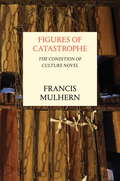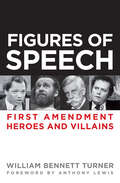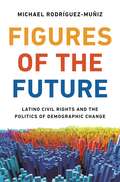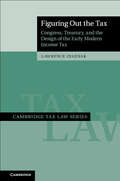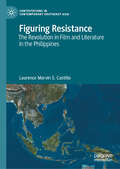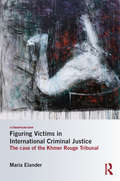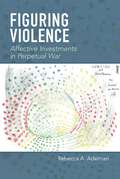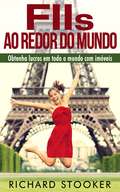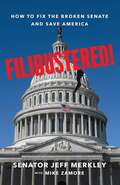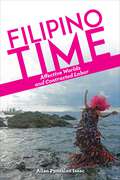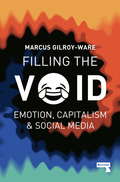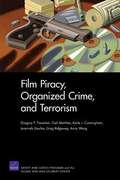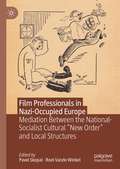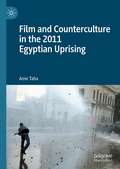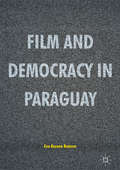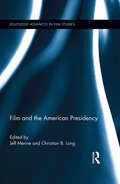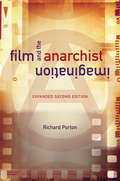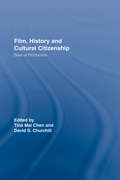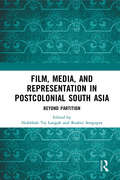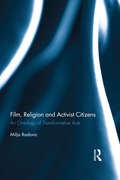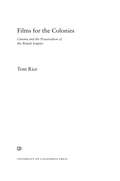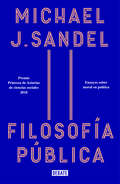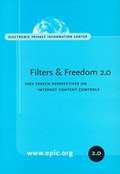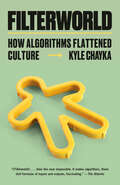- Table View
- List View
Figures of Catastrophe
by Francis MulhernA bold new vision of the modern English novelThe leading critic Francis Mulhern uncovers a hidden history in the fiction of the past century, identifying a central new genre: the condition of culture novel. Reading across and against the grain of received patterns of literary association, tracing a line from Hardy and Forster, through Woolf, Waugh and Bowen, to Barstow, Fowles, Rendell, Naipaul, Amis, Kureishi and Smith, he elucidates the recurring topics and narrative logics of the genre, showing how culture emerges as a special ground of social conflict, above all between classes. The narrative evaluations of culture's ends--the aspirations and the destinies of those whose lives are the subject of these novels--grow steadily darker over time, and the writing itself grows more introverted.A concluding discussion elicits the characteristics of the English condition of culture novel, in an international setting, and closes in, finally, on the central conundrum of the genre: its uncanny reprise, in its own plane, of the historical arc of the modern labour movement in Britain, from its beginnings in the late nineteenth century through its post-war heyday to the seemingly inexorable decline of recent decades.From the Hardcover edition.
Figures of Speech: First Amendment Heroes and Villains
by William TurnerRecounting controversial First Amendment cases from the Red Scare era to Citizens United, William Bennett Turner—a Berkeley law professor who has argued three cases before the Supreme Court—shows how we’ve arrived at our contemporary understanding of free speech. His strange cast of heroes and villains, some drawn from cases he has litigated, includes Communists, Jehovah’s Witnesses, Ku Klux Klansmen, the world’s leading pornographer, prison wardens, dogged reporters, federal judges, a computer whiz, and a countercultural comedian. This is a fascinating look at how the scope of our First Amendment freedoms has evolved and the colorful characters behind some of the most important legal decisions of modern times. “Turner tells fascinating stories of unlikely heroes and explains difficult legal issues clearly and concisely, educating and entertaining at the same time.”—Elizabeth Farnsworth, The PBS News Hour
Figures of the Future: Latino Civil Rights and the Politics of Demographic Change
by Michael Rodríguez-MuñizAn in-depth look at how U.S. Latino advocacy groups are using ethnoracial demographic projections to bring about political change in the presentFor years, newspaper headlines, partisan speeches, academic research, and even comedy routines have communicated that the United States is undergoing a profound demographic transformation—one that will purportedly change the “face” of the country in a matter of decades. But the so-called browning of America, sociologist Michael Rodríguez-Muñiz contends, has less to do with the complexion of growing populations than with past and present struggles shaping how demographic trends are popularly imagined and experienced. Offering an original and timely window into these struggles, Figures of the Future explores the population politics of national Latino civil rights groups.Based on eight years of ethnographic and qualitative research, spanning both the Obama and Trump administrations, this book investigates how several of the most prominent of these organizations—including UnidosUS (formerly NCLR), the League of United Latin American Citizens, and Voto Latino—have mobilized demographic data about the Latino population in dogged pursuit of political recognition and influence. In census promotions, get-out-the-vote campaigns, and policy advocacy, this knowledge has been infused with meaning, variously serving as future-oriented sources of inspiration, emblems for identification, and weapons for contestation. At the same time, Rodríguez-Muñiz considers why these political actors have struggled to translate this demographic growth into tangible political gain and how concerns about white backlash have affected how they forecast demographic futures.Figures of the Future looks closely at the politics surrounding ethnoracial demographic changes and their rising influence in U.S. public debate and discourse.
Figuring Out the Tax Congress: Treasury, and the Design of the Early Modern Income Tax (Cambridge Tax Law Series)
by Lawrence ZelenakFiguring Out the Tax recounts the forgotten early development of the federal income tax in the US, resulting from the interplay between Congress and the Treasury Department in the decades following the enactment of the tax in 1913. It covers a wide range of topics including the income tax treatments of marriage, capital losses, charitable contributions and homeownership, as well as the rise, demise and resurrection of income tax withholding. Lawrence Zelenak deftly illustrates how the income tax achieved its current form through a range of stories which are new to tax history scholarship and involve some remarkable personalities and surprising plot twists. Although of particular interest to tax academics and professionals, this book will also serve as a useful introduction to the development of income tax for undergraduate students and law students. Recounts important developments in the early history of the income tax utilising new material which is not covered in existing tax history scholarship. Adopts a chronological narrative approach, making for an entertaining read. Does not assume any particular background in income tax law and will be accessible to a general readership with an interest in income tax.
Figuring Resistance: The Revolution in Film and Literature in the Philippines (Contestations in Contemporary Southeast Asia)
by Laurence Marvin CastilloThis book examines how fiction films and novels represent the communist-led national democratic (NatDem) revolution in the Philippines. Produced aboveground decades after the Philippines’ historic transition from dictatorship to elite democracy, these NatDem fictions depict how the communist movement in the Philippines confronted various national and global changes, tracking revolutionary experiences amidst the ascendancy of neoliberalism, the continuation of counterinsurgency and the emergence of non-Marxist social movements and discourses. Figuring Resistance studies how fictions portray the tenacity of political commitment among revolutionaries engaged in the revolution's manifold history of crises, setbacks, and persistence. It illuminates the crucial role played by cultural work in creating and nourishing an oppositional public sphere, where the experiential makings of the liberation struggle in the Third World can be imagined.
Figuring Victims in International Criminal Justice: The case of the Khmer Rouge Tribunal
by Maria ElanderMost discourses on victims in international criminal justice take the subject of victims for granted, as an identity and category existing exogenously to the judicial process. This book takes a different approach. Through a close reading of the institutional practices of one particular court, it demonstrates how court practices produce the subjectivity of the victim, a subjectivity that is profoundly of law and endogenous to the enterprise of international criminal justice. Furthermore, by situating these figurations within the larger aspirations of the court, the book shows how victims have come to constitute and represent the link between international criminal law and the enterprise of transitional justice. The book takes as its primary example the Extraordinary Chambers in the Courts of Cambodia (ECCC), or the Khmer Rouge Tribunal as it is also called. Focusing on the representation of victims in crimes against humanity, victim participation and photographic images, the book engages with a range of debates and scholarship in law, feminist theory and cultural legal theory. Furthermore, by paying attention to a broader range of institutional practices, Figuring Victims makes an innovative scholarly contribution to the debates on the roles and purposes of international criminal justice.
Figuring Violence: Affective Investments in Perpetual War
by Rebecca A. AdelmanIn the United States, the early years of the war on terror were marked by the primacy of affects like fear and insecurity. These aligned neatly with the state’s drive toward intensive securitization and an aggressive foreign policy. But for the broader citizenry, such affects were tolerable at best and unbearable at worst; they were not sustainable. Figuring Violence catalogs the affects that define the latter stages of this war and the imaginative work that underpins them. These affects—apprehension, affection, admiration, gratitude, pity, and righteous anger—are far more subtle and durable than their predecessors, rendering them deeply compatible with the ambitions of a state embroiling itself in a perpetual and unwinnable war.Surveying the cultural landscape of this sprawling conflict, Figuring Violence reveals the varied mechanisms by which these affects have been militarized. Rebecca Adelman tracks their convergences around six types of beings: civilian children, military children, military spouses, veterans with PTSD and TBI, Guantánamo detainees, and military dogs. All of these groups have become preferred objects of sentiment in wartime public culture, but they also have in common their status as political subjects who are partially or fully unknowable. They become visible to outsiders through a range of mediated and imaginative practices that are ostensibly motivated by concern or compassion. However, these practices actually function to reduce these beings to abstracted figures, silencing their political subjectivities and obscuring their suffering. As a result, they are erased and rendered hypervisible at once. Figuring Violence demonstrates that this dynamic ultimately propagates the very militarism that begets their victimization.
Fiis Ao Redor Do Mundo
by Richard Stooker Káren Guedes AlbinoTenha a sua parte nos lucros dos Fundos de Investimento Imobiliário - FII (Real Estate Investment Trust - REIT) em todo o mundo!A partir do momento em que várias empresas imobiliárias se converteram em Fundos de Investimento Imobiliário e seguraram os IPOs em meados da década de 1990 - e também com a publicação da primeira edição do Investing in REITs: Real Estate Investment Trusts de Ralph L. Block, U.S.; investidores dos EUA têm descoberto os altos lucros possíveis que eles podem ter por meio do investimento em imóveis comerciais através de empresas de capital aberto.Os FIIS (ou REITs) não têm que pagar impostos sobre os dividendos que são distribuídos aos seus titulares de unidades - e o governo obriga-os a repassar 90%!Diversos países do mundo têm seguido os EUA - líder mundial neste segmento - e também têm criado suas próprias versões dos Fundos de Investimento Imobiliário. Neste sentido, cerca de 40 países, da Austrália à Turquia, têm leis que permitem alguma forma de FII, usando os EUA como modelo, mas imprimindo as suas próprias particularidades.Ao investir em FIIs você pode:1 - Ter um fluxo de renda que não depende do dólar americano (ou do euro, ou do iene, ou de qualquer que seja a moeda de seu país).Ou seja, você pode obter renda em uma grande variedade de moedas, que podem se valorizar enquanto o dólar cai, por exemplo.Os dois maiores, mais antigos e maduros países em termos de FIIs do mundo são os EUA, o Canadá e a Austrália. Então, eu te pergunto: quais são os dois países cujas moedas têm se valorizado drasticamente: Canadá e Austrália. E é fato que tanto canadenses quanto australianos precisam de apartamentos, de edifícios de escritórios e de centros comerciais, tal como acontece em qualquer outro país. Assim, ao comprar ações de seus FIIs você pode obter alguns dólares australianos e canadenses.2 - Ter
Filibustered!: How To Fix The Broken Senate And Save America
by Jeff Merkley Mike ZamoreThe U.S. Senator from Oregon who is leading the fight to restore the talking filibuster explains how changing just one rule could save our democracy If we want to fix what ails America, we have to fix the Senate. And if we want to fix the Senate, we must fix the broken filibuster. In a compelling and powerfully argued book, Senator Jeff Merkley and his longtime chief of staff tell the insiders’ story of how the Senate used to work and how the filibuster came to cripple the self-styled “World’s Greatest Deliberative Body” with paralyzing gridlock. And they make the surprising case that restoring a modified version of the old-style, talking filibuster may just be our democracy’s path back from the brink. For nearly two centuries, the Senate designed by the Founders served the purpose they envisioned: it was a deliberative legislative body where the nation’s thorniest challenges were hashed out. Senators had the ability to speak at length and offer any manner of amendments to influence bills, and then when all had had a say, the Senate voted. Senators who objected to passing a bill could wage a defiant filibuster—in the spirit of fictional Senator Smith who talked until he collapsed in order to block a corrupt railroad deal in the classic 1939 film Mr. Smith Goes to Washington. But at the end of the day, nearly all legislation, amendments, and nominations went to a vote, and the majority prevailed. Today, however, thanks to abuse of a fifty-year-old reform intended to make it easier for the Senate to pass legislation, the exceedingly difficult, rare filibuster has morphed, plunging the Senate into dysfunction and threatening the very foundations of our democracy. Now, the minority party can simply declare a “no-talk” filibuster, insisting on a supermajority of sixty votes to pass nearly any bill or a lengthy process to confirm any of the president’s nominees—giving themselves a veto over the majority’s agenda. Wildly popular bills languish, judgeships and administrative posts remain unfilled, but ordinary citizens can’t see why because the obstruction all takes place behind closed doors. Filibustered! combines a marvelous romp through key moments in filibuster history—from the first filibuster in 1841 through Southern Dixiecrat filibusters of civil rights legislation, up through Mitch McConnell’s transformation of the filibuster into a routine tool of perennial gridlock—with firsthand accounts of recent high-profile legislative fights, and a compelling argument that the key to the Senate’s future may be found in its past.
Filipino Time: Affective Worlds and Contracted Labor
by Allan Punzalan IsaacFrom spectacular deaths in a drag musical to competing futures in a call center, Filipino Time examines how contracted service labor performed by Filipinos in the Philippines, Europe, the Middle East, and the United States generates vital affects, multiple networks, and other lifeworlds as much as it disrupts and dislocates human relations. Affective labor and time are re-articulated in a capacious archive of storytelling about the Filipino labor diaspora in fiction, musical performance, ethnography, and documentary film. Exploring these cultural practices, Filipino Time traces other ways of sensing, making sense of, and feeling time with others, by weaving narratives of place and belonging out of the hostile but habitable textures of labortime. Migrant subjects harness time and the imagination in their creative, life making capacities to make communal worlds out of one steeped in the temporalities and logics of capital.
Filipinx American Studies: Reckoning, Reclamation, Transformation
by Rick Bonus and Antonio T. TiongsonThis volume spotlights the unique suitability and situatedness of Filipinx American studies both as a site for reckoning with the work of historicizing U.S. empire in all of its entanglements, as well as a location for reclaiming and theorizing the interlocking histories and contemporary trajectories of global capitalism, racism, sexism, and heteronormativity. It encompasses an interrogation of the foundational status of empire in the interdiscipline; modes of labor analysis and other forms of knowledge production; meaning-making in relation to language, identities, time, and space; the critical contours of Filipinx American schooling and political activism; the indispensability of relational thinking in Filipinx American studies; and the disruptive possibilities of Filipinx American formations. A catalogue of key resources and a selected list of scholarship are also provided. Filipinx American Studies constitutes a coming-to-terms with not only the potentials and possibilities but also the disavowals, silences, and omissions that mark Filipinx American studies. It provides a reflective and critical space for thinking through the ways Filipinx American studies is uniquely and especially suited to the interrogation of the ongoing legacies of U.S. imperialism and the urgencies of the current period.Contributors: Karin Aguilar-San Juan, Angelica J. Allen, Gina Apostol, Nerissa S. Balce, Joi Barrios-Leblanc, Victor Bascara, Jody Blanco, Alana Bock, Sony Coráñez Bolton, Lucy Mae San Pablo Burns, Richard T. Chu, Gary A. Colemnar, Kim Compoc, Denise Cruz, Reuben B. Deleon, Josen Masangkay Diaz, Robert Diaz, Kale Bantigue Fajardo, Theodore S. Gonzalves, Vernadette Vicuña Gonzalez, Anna Romina Guevara, Allan Punzalan Isaac, Martin F. Manalansan IV, Dina C. Maramba, Cynthia Marasigan, Edward Nadurata, JoAnna Poblete, Anthony Bayani Rodriguez, Dylan Rodríguez, Evelyn Ibatan Rodriguez, Robyn Magalit Rodriguez, J. A. Ruanto-Ramirez, Jeffrey Santa Ana, Dean Itsuji Saranillio, Michael Schulze-Oechtering, Sarita Echavez See, Roy B. Taggueg Jr.
Filling the Void: Social Media and The Continuation of Capitalism
by Marcus Gilroy-WareFilling The Void is a book about how the cultures and psychology of social media use fit within a broader landscape of life under capitalism. It argues that social media use is often a psychological response to the need for pleasure and comfort that results from the stresses of life under postmodern capitalism, rather than being a driver of new behaviours as newer technologies are often said to be. Both the explosive growth of social media and the corresponding reconfiguration of the web from an information-based platform into an entertainment-based one are far more easily explained in terms of the subjective psychological experience of their users as capitalist subjects seeking 'depressive hedonia,' the book argues. Filling the Void also interrogates the role of social media networks, designed for private commercial gain, as part of a de-facto public sphere. Both the decreasing subjective importance of factual media and the ways in which the content of the timeline are quietly manipulated--often using labour in the developing world and secret algorithms--have potentially serious implications for the capacity of social media users to query or challenge the seeming reality offered by the established hegemonic order.
Film Piracy, Organized Crime, and Terrorism
by Carl Matthies Karla J Cunningham Jeremiah Gouka Gregory F Treverton Greg RidgewayA study of the involvement of organized-crime and terrorist groups in product counterfeiting. Case studies of film piracy illustrate the problem of criminal--and perhaps terrorist--groups using this new high-payoff, low-risk way to fund their activities. Cooperation among law enforcement and governments worldwide is needed to combat intellectual-property theft, which threatens the global information economy, public safety, and national security.
Film Professionals in Nazi-Occupied Europe: Mediation Between the National-Socialist Cultural “New Order” and Local Structures
by Roel Vande Winkel Pavel SkopalThis book analyses the film industries and cinema cultures of Nazi-occupied countries (1939-1945) from the point of view of individuals: local captains of industry, cinema managers, those working for film studios and officials authorized to navigate film policy. The book considers these people from a historical perspective, taking into account their career before the occupation and, where relevant, pays attention to their post-war lives. The perspectives of these historical agents” contributes to an understanding of how top-down orders and haphazard signals from the occupying administration were moulded, adjusted and distorted in the process of their translation and implementation. This edited collection offers a more dynamic and less deterministic approach to research on the international expansion of Third-Reich cinema in World War Two; an approach that strives to balance the role of individual agency with the structural determinants. The case studies presented in this book cover the territories of Belgium, Czechoslovakia, France, the Netherlands, Norway, Poland and the Soviet Union.
Film and Counterculture in the 2011 Egyptian Uprising
by Amir TahaThis book examines how film articulates countercultural flows in the context of the Egyptian Revolution. The book interrogates the gap between radical politics and radical aesthetics by analyzing counterculture as a form, drawing upon Egyptian films produced between 2010 and 2016. The work offers a definition of counterculture which liberates the term from its Western frame and establishes a theoretical concept of counterculture which is more globally redolent. The book opens a door for further research of the Arab Uprising, arguing for a new and topical model of rebellion and struggle, and sheds light on the interaction between cinema and the street as well as between cultural narratives and politics in the context of the 2011 Egyptian uprising. What is counterculture in the twenty-first century? What role does cinema play in this new notion of counterculture?
Film and Democracy in Paraguay
by Eva Karene RomeroThis book is dedicated to the study of Paraguayan film, particularly small cinemas and movies which represent a socio-politically charged perspective that has until now been overlooked in Latin American Studies. Romero demonstrates that these films are critical to understanding the dynamics of politics and cultural identity in Latin America as a whole. An in-depth exploration of the Latin American post-dictatorial transition of power Romero investigates this contemporary crisis through the dynamics of race, class, gender, and sexuality. Each chapter takes a film or films as its jumping off point, then zooms out to encompass elements of the national political, economic, social, and historical context. Romero analyzes some of the most pressing social issues in Paraguay while reflecting on the power of cultural discourse through film.
Film and the American Presidency (Routledge Advances in Film Studies)
by Jeff Menne Christian B. LongThe contention of Film and the American Presidency is that over the twentieth century the cinema has been a silent partner in setting the parameters of what we might call the presidential imaginary. This volume surveys the partnership in its longevity, placing stress on especially iconic presidents such as Lincoln and FDR. The contributions to this collection probe the rich interactions between these high institutions of culture and politics—Hollywood and the presidency—and argue that not only did Hollywood acting become an idiom for presidential style, but that Hollywood early on understood its own identity through the presidency’s peculiar mix of national epic and unified protagonist. Additionally, they contend that studios often made their films to sway political outcomes; that the performance of presidential personae has been constrained by the kinds of bodies (for so long, white and male) that have occupied the office, such that presidential embodiment obscures the body politic; and that Hollywood and the presidency may finally be nothing more than two privileged figures of media-age power.
Film and the Anarchist Imagination: Expanded Second Edition
by Richard PortonHailed since its initial release, Film and the Anarchist Imagination offers the authoritative account of films featuring anarchist characters and motifs. Richard Porton delves into the many ways filmmakers have portrayed anarchism’s long traditions of labor agitation and revolutionary struggle. While acknowledging cinema’s predilection for ludicrous anarchist stereotypes, he focuses on films that, wittingly or otherwise, reflect or even promote workplace resistance, anarchist pedagogy, self-emancipation, and anti-statist insurrection. Porton ranges from the silent era to the classics Zéro de Conduite and Love and Anarchy to contemporary films like The Nothing Factory while engaging the works of Jean Vigo, Jean-Luc Godard, Lina Wertmüller, Yvonne Rainer, Ken Loach, and others. For this updated second edition, Porton reflects on several new topics, including the negative portrayals of anarchism over the past twenty years and the contemporary embrace of post-anarchism.
Film, History and Cultural Citizenship: Sites of Production (Routledge Studies in Cultural History)
by Tina Mai Chen; David S. ChurchillThis new book investigates the relationship of film to history, power, memory, and cultural citizenship. The book is concerned with two central issues: firstly, the participation of film and filmmakers in articulating and challenging projects of modernity; and, secondly, the role of film in shaping particular understandings of self and other to evoke collective notions of belonging. These issues call for interdisciplinary and multi-layered analyses that are ideally met through dialogue across place, time, identities and genres. The contributors to this volume enable this dialogue by considering the ways in which cultural expression and identity expressed through film serve to create notions of belonging, group identity, and entitlement within modern societies.
Film, Media and Representation in Postcolonial South Asia: Beyond Partition
by Nukhbah Taj LangahThis volume brings together new studies and interdisciplinary research on the changing mediascapes in South Asia. Focusing on India, Pakistan, and Bangladesh, it explores the transformations in the sphere of cinema, television, performing arts, visual cultures, cyber space and digital media, beyond the traumas of the partitions of 1947 and 1971. Through wide-ranging essays on soft power, performance, film, and television; art and visual culture; and cyber space, social media, and digital texts, the book bridges the gap in the study of the postcolonial and post-Partition developments to reimagine South Asia through a critical understanding of popular culture and media. The volume includes scholars and practitioners from the subcontinent to foster dialogue across the borders, and presents diverse and in-depth studies on film, media and representation in the region. This book will be useful to scholars and researchers of media and film studies, postcolonial studies, visual cultures, political studies, partition history, cultural studies, mass media, popular culture, history, sociology and South Asian studies, as well as to media practitioners, journalists, writers, and activists.
Film, Religion and Activist Citizens: An ontology of transformative acts
by Milja RadovicFilm can be a socio-political and artistic-transformative cultural practice through which acts and activism are performed. Going beyond ideological constructs of activism and legal definitions of citizenship, this book offers a novel approach to understanding the ontology of acts and activist citizenship, particularly in the context of their expression through film. The author approaches film as act and focuses on the scene of film as a space that goes beyond representation, constituting its own reality through which activist citizens emerge. By looking at autonomous creative acts through a range of directors' works from across the world, the author explores both the ontological and ontic dimensions of transformative acts of citizenship. In doing this the author poses the question of whether citizens are stepping out of dominant cultural ideologies to overcome social, ethnic, religious and economic divisions. This book is a fresh exploration of the ontology of acts and is essential reading for any academic interested in religion, theology, film and citizenship studies.
Films for the Colonies: Cinema and the Preservation of the British Empire
by Tom RiceFilms for the Colonies examines the British Government’s use of film across its vast Empire from the 1920s until widespread independence in the 1960s. Central to this work was the Colonial Film Unit, which produced, distributed, and, through its network of mobile cinemas, exhibited instructional and educational films throughout the British colonies. Using extensive archival research and rarely seen films, Films for the Colonies provides a new historical perspective on the last decades of the British Empire. It also offers a fresh exploration of British and global cinema, charting the emergence and endurance of new forms of cinema culture from Ghana to Jamaica, Malta to Malaysia. In highlighting the integral role of film in managing and maintaining a rapidly changing Empire, Tom Rice offers a compelling and far-reaching account of the media, propaganda, and the legacies of colonialism.
Filosofía pública: Ensayos sobre moral en política
by Michael J. SandelUna recopilación de ensayos imprescindible sobre la moral en política. En este libro, Michael Sandel aborda algunos de los temas morales y políticos más controvertidos de nuestro tiempo, incluidos el suicidio asistido, el aborto, la investigación con células madre, la brecha entre ricos y pobres, el papel de los mercados y el lugar de la religión en la vida política. Sostiene que los ideales más prominentes en nuestra vida política, los derechos individuales y la libertad de elección, no proporcionan por sí mismos una ética adecuada para una sociedad democrática. Estos ensayos demuestran que el discurso moral no está reñido con los propósitos progresivos, y que una sociedad pluralista no necesita evitar involucrarse en las convicciones morales y religiosas que sus ciudadanos aportan a la vida pública. Reseñas:«Michael Sandel es uno de los teóricos políticos más conocidos e influyentes del mundo. Se destaca por lavariedad de cuestiones éticas prácticas que ha abordado: vida, muerte, deportes, religión, comercio y más. Estos ensayos son lúcidos, afilados, a menudo muy sutiles, y reveladores. Sandel tiene algo importante y valioso que decir sobre cada tema que aborda.»Stephen Macedo, Universidad de Princeton «[Sandel] explica que nuestra vida en una sociedad pluralista con diferentes ideales morales no obstaculiza la discusión sobre temas como el aborto y la investigación con células madre, sino que nos ayuda a resolverlos observando lo que significa vivir 'una buena vida'. Este libro estimulante será valioso tanto para el lector general como para los académicos.»Scott Duimstra, Library Journal «Cualquiera interesado sobre el éxito político del conservadurismo en los últimos años debe estar interesado en este análisis crítico.»Thomas Nagel, The New York Review of Books «Este nuevo volumen, que recopila artículos publicados anteriormente entre 1983y 2004, proporciona una visión general valiosa de lo que Sandel llama su "filosofía pública" ... Sus argumentos son amplios, lúcidos y sinceros en su preocupación por nuestras actuales enfermedades públicas. Como tales, exigen atención y compromiso.»William Lund, Social Theory and Practice «Siempre se puede contar con Michael Sandel para escribir con elegancia e inteligencia sobre asuntos importantes. Estés o no de acuerdo, no puedes ignorar sus argumentos. Necesitamos todas las voces sensatas que podamos obtener en el debate público y la de Sandel es una de las más sensatas.»Jean Bethke Elshtain, Escuela de Divinidad de la Universidad de Chicago «No importa cuáles sean tus ideas políticas, verás que Filosofía pública de Michael Sandel es emocionante, estimulante, exigente y alentador.»E.J. Dionne Jr.; columnista y profesor en Georgetown University
Filters and Freedom 2.0: Free Speech Perspective on Internet Content Controls
by Electronic Privacy Information CenterFilters and Freedom 2.0 examines how Internet filtering and rating systems relate to freedom of expression. Originally proposed as a technological solution that would forestall official censorship, content filtering has been shown to pose its own significant threats to free expression on the Internet.
Filterworld: How Algorithms Flattened Culture
by Kyle ChaykaA MOST ANTICIPATED BOOK • From New Yorker staff writer and author of The Longing for Less Kyle Chayka comes a timely history and investigation of a world ruled by algorithms, which determine the shape of culture itself."[Filterworld] is about how algorithms changed culture…[Chayka asks] what is taste? What is a sense of aesthetics? And what happens to it when it collides with the homogenizing digital reality in which we now live."—Ezra KleinFrom trendy restaurants to city grids, to TikTok and Netflix feeds the world round, algorithmic recommendations dictate our experiences and choices. The algorithm is present in the familiar neon signs and exposed brick of Internet cafes, be it in Nairobi or Portland, and the skeletal, modern furniture of Airbnbs in cities big and small. Over the last decade, this network of mathematically determined decisions has taken over, almost unnoticed—informing the songs we listen to, the friends with whom we stay in touch—as we&’ve grown increasingly accustomed to our insipid new normal.This ever-tightening web woven by algorithms is called &“Filterworld.&” Kyle Chayka shows us how online and offline spaces alike have been engineered for seamless consumption, becoming a source of pervasive anxiety in the process. Users of technology have been forced to contend with data-driven equations that try to anticipate their desires—and often get them wrong. What results is a state of docility that allows tech companies to curtail human experiences—human lives—for profit. But to have our tastes, behaviors, and emotions governed by computers, while convenient, does nothing short of call the very notion of free will into question.In Filterworld, Chayka traces this creeping, machine-guided curation as it infiltrates the furthest reaches of our digital, physical, and psychological spaces. With algorithms increasingly influencing not just what culture we consume, but what culture is produced, urgent questions arise: What happens when shareability supersedes messiness, innovation, and creativity—the qualities that make us human? What does it mean to make a choice when the options have been so carefully arranged for us? Is personal freedom possible on the Internet?To the last question, Filterworld argues yes—but to escape Filterworld, and even transcend it, we must first understand it.
